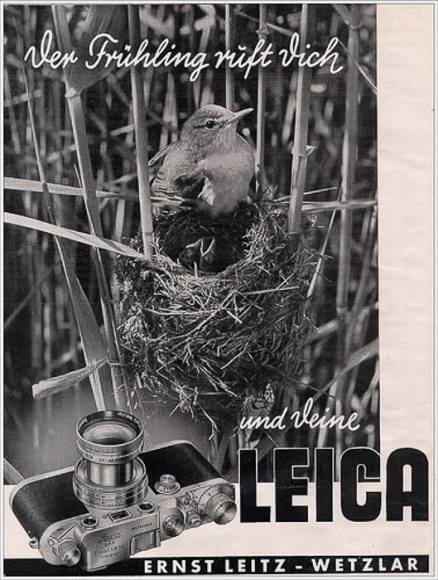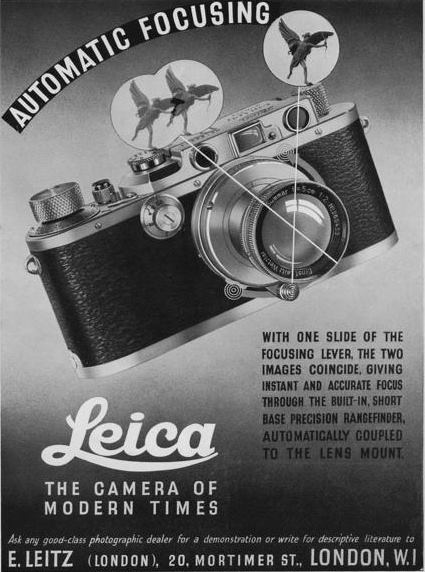I love looking at vintage advertisements, in particularly listings of prices for new and secondhand gear. Somehow they put things in perspective. Old receipts are even more fascinating as I showed in my story of the Woolwich Leica IIIc and when William Fagan told us about his father’s 1940 Super Baldina.

It’s not surprising, then, that I found this compendium of old ads on LeicaRumors of more than passing interest. While the emphasis is very much on US advertising through the years, there are one or two (such as the E.Leitz layout above) with a British slant. The American listings show a lot of detail, including two interesting prices, from around 1955, for a IIIg at $342 and an M3 at $456. Both these prices include a lens, by the way. In an earlier ad we find a IIIf with 50mm Summicron being offered new for $336 and a bargain IIf with 50mm Elmar at $177. In yet another instance, a pre-war listing has a Leica Model D with 3.5cm Elmar lens for only $84.

Bargains
It is difficult to translate these prices into current pounds sterling because of the problems of both exchange rates and inflation. Before the war, at the time of the Model D, there were four dollars to the pound, so that little package would have equated £21 at the time.
This could have been second hand because, in one of the British listings, I find a used Leica Model III with f/2 Summar available at City Sale in London, for £39. 10s. This, I feel sure, is from the 1930s. After the war the pound settled down at an exchange rate $2.60 so the 1950s prices above equate to £130 for the new IIIg and lens or £175 for the M3 and lens. About right, I suspect.
Ten quid a week
The ~1955 M3 with 50mm Summicron at $456 (£175) can be compared directly with a the new Leica M-A, which is very similar in specification to the M3, and a current 50mm Summicron. The MA is £3,275 and the Summicron £1,750. So, around £5,000 buys you now what you could have had in 1955 for £175. I judge this to be about right in terms of earning power (£10 a week was an above-average wage in 1955) and commodity values.
Leicas may seem expensive now but, in reality, they were just as costly in 1955 when you could have bought a good used car for the same money as the M3 and Summicron. Interestingly, in decent condition, the £175 M3 outfit from 1955 would still fetch around £1,000 today: Not bad as a deposit on a new M-A and modern lens after 60 years of use.



Dear Mike
This is an interesting article about relative values of Leica cameras over time. One aspect of consumer behaviour that is very difficult to factor in, is the fact that the consumer of today has far more choices and things to spend his/her money on compared to the consumer of, say, the 1930s eg, foreign travel, motor vehicle ownership, TV, internet, mobile phones, eating out etc, etc. Perceived value is still, however, important in a market with many more choices.
For those of us with a weird (to some) old camera collecting habit, there are, of course, other factors at play, particularly when such items come up at auction. Some models can fetch 10s of thousands ( choose any currency, the effect is the same), others 100s of thousands and, in a few very rare cases, millions. The usual criteria in that market for perceived value are not functions and utility (as is the case with new cameras) but rather rarity, condition and, that most difficult to define concept, desirability. In the case of Leica M models, black paint items fetch higher prices because they are rare. In the case of the Leica II Model D, black lacquer and nickel models go for more than chrome ones, even though the former are more common. In this case, desirability is the determining criterion. Then you get the desire for ‘original condition’ which causes cameras which have been upgraded, even in the factory by Leica, to sell for less than items which have not been upgraded. At that stage utility has to take a back seat.
Prices at auction can vary a lot as a quick glance here will show:http://collectiblend.com/Cameras/Leitz/
This is, indeed, an example of a market economy where prices are set by buyers pursuing scarce goods. Interestingly, however, Leica AG has in the last year purchased a majority shareholding in two of the larger European camera auction houses specializing in Leica cameras, Westlicht in Vienna and Rahn in Frankfurt. There is food for thought here, as the auction market must be working to encourage such investment.
William Fagan